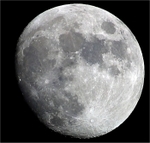By Laura G. Smith

|
Moon Talk
By Laura G. Smith |

|
 1 It's the Earth's only natural satellite-a glowing globe that appears in the night sky capturing the attention of all who gaze in its direction. Although the Earth's moon seems to be "shining" its own light, it is really reflecting light from the sun. Some nights the moon looks like a huge, round, shiny ball, and other nights it appears as just a thin sliver of light. Although the moon seems to be changing shapes, it really isn't. It just looks different because it is reflecting varying amounts of sunlight during each of its phases.
1 It's the Earth's only natural satellite-a glowing globe that appears in the night sky capturing the attention of all who gaze in its direction. Although the Earth's moon seems to be "shining" its own light, it is really reflecting light from the sun. Some nights the moon looks like a huge, round, shiny ball, and other nights it appears as just a thin sliver of light. Although the moon seems to be changing shapes, it really isn't. It just looks different because it is reflecting varying amounts of sunlight during each of its phases. F and as low as -280
F and as low as -280  F. In some of the moon's deepest craters, the temperature stays near -400
F. In some of the moon's deepest craters, the temperature stays near -400 F! Earth, on the other hand, has a protective blanket of invisible insulation - the atmosphere - which protects it from such extreme temperature changes.
F! Earth, on the other hand, has a protective blanket of invisible insulation - the atmosphere - which protects it from such extreme temperature changes. |
Create Weekly Reading Books
Prepare for an entire week at once! |
| Leave your feedback on Moon Talk (use this link if you found an error in the story) |
 |
Solar System and Planets
|
 |
Free Moon Worksheets | edHelper.com
|
 |
Science
|